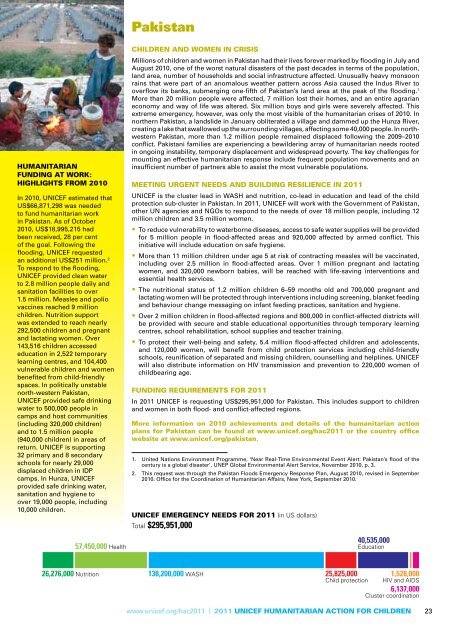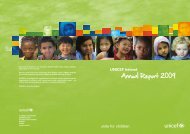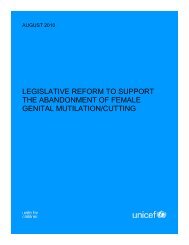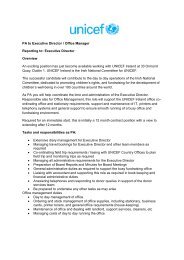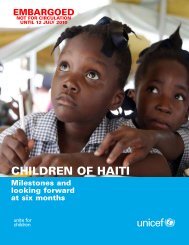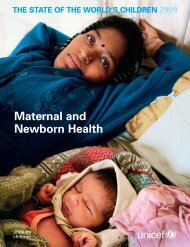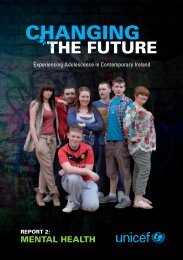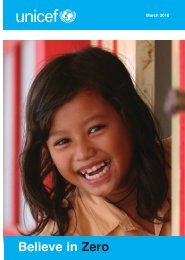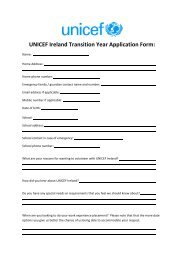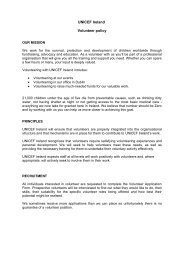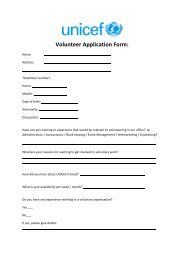Humanitarian Action for Children 2011 - Unicef
Humanitarian Action for Children 2011 - Unicef
Humanitarian Action for Children 2011 - Unicef
- No tags were found...
Create successful ePaper yourself
Turn your PDF publications into a flip-book with our unique Google optimized e-Paper software.
Pakistan<strong>Humanitarian</strong>funding at work:Highlights from 2010In 2010, UNICEF estimated thatUS$66,871,298 was neededto fund humanitarian workin Pakistan. As of October2010, US$18,995,215 hadbeen received, 28 per centof the goal. Following theflooding, UNICEF requestedan additional US$251 million. 2To respond to the flooding,UNICEF provided clean waterto 2.8 million people daily andsanitation facilities to over1.5 million. Measles and poliovaccines reached 9 millionchildren. Nutrition supportwas extended to reach nearly292,500 children and pregnantand lactating women. Over143,516 chil dren accessededucation in 2,522 temporarylearning centres, and 104,400vulnerable children and womenbenefited from child-friendlyspaces. In politically unstablenorth-western Pakistan,UNICEF provided safe drinkingwater to 500,000 people incamps and host communities(including 320,000 children)and to 1.5 million people(940,000 children) in areas ofreturn. UNICEF is supporting32 primary and 8 secondaryschools <strong>for</strong> nearly 29,000displaced children in IDPcamps. In Hunza, UNICEFprovided safe drinking water,sanitation and hygiene toover 19,000 people, including10,000 children.57,450,000 Health<strong>Children</strong> and women in crisisMillions of children and women in Pakistan had their lives <strong>for</strong>ever marked by flooding in July andAugust 2010, one of the worst natural disasters of the past decades in terms of the population,land area, number of households and social infrastructure affected. Unusually heavy monsoonrains that were part of an anomalous weather pattern across Asia caused the Indus River tooverflow its banks, submerging one-fifth of Pakistan’s land area at the peak of the flooding. 1More than 20 million people were affected, 7 million lost their homes, and an entire agrarianeconomy and way of life was altered. Six million boys and girls were severely affected. Thisextreme emergency, however, was only the most visible of the humanitarian crises of 2010. Innorthern Pakistan, a landslide in January obliterated a village and dammed up the Hunza River,creating a lake that swallowed up the surrounding villages, affecting some 40,000 people. In northwesternPakistan, more than 1.2 million people remained displaced following the 2009–2010conflict. Pakistani families are experiencing a bewildering array of humanitarian needs rootedin ongoing instability, temporary displacement and widespread poverty. The key challenges <strong>for</strong>mounting an effective humanitarian response include frequent population movements and aninsufficient number of partners able to assist the most vulnerable populations.Meeting urgent needs and building resilience in <strong>2011</strong>UNICEF is the cluster lead in WASH and nutrition, co-lead in education and lead of the childprotection sub-cluster in Pakistan. In <strong>2011</strong>, UNICEF will work with the Government of Pakistan,other UN agencies and NGOs to respond to the needs of over 18 million people, including 12million children and 3.5 million women.• To reduce vulnerability to waterborne diseases, access to safe water supplies will be provided<strong>for</strong> 5 million people in flood-affected areas and 920,000 affected by armed conflict. Thisinitiative will include education on safe hygiene.• More than 11 million children under age 5 at risk of contracting measles will be vaccinated,including over 2.5 million in flood-affected areas. Over 1 million pregnant and lactatingwomen, and 320,000 newborn babies, will be reached with life-saving interventions andessential health services.• The nutritional status of 1.2 million children 6–59 months old and 700,000 pregnant andlactating women will be protected through interventions including screening, blanket feedingand behaviour change messaging on infant feeding practices, sanitation and hygiene.• Over 2 million children in flood-affected regions and 800,000 in conflict-affected districts willbe provided with secure and stable educational opportunities through temporary learningcentres, school rehabilitation, school supplies and teacher training.• To protect their well-being and safety, 5.4 million flood-affected children and adolescents,and 120,000 women, will benefit from child protection services including child-friendlyschools, reunification of separated and missing children, counselling and helplines. UNICEFwill also distribute in<strong>for</strong>mation on HIV transmission and prevention to 220,000 women ofchildbearing age.Funding requirements <strong>for</strong> <strong>2011</strong>In <strong>2011</strong> UNICEF is requesting US$295,951,000 <strong>for</strong> Pakistan. This includes support to childrenand women in both flood- and conflict-affected regions.More in<strong>for</strong>mation on 2010 achievements and details of the humanitarian actionplans <strong>for</strong> Pakistan can be found at www.unicef.org/hac<strong>2011</strong> or the country officewebsite at www.unicef.org/pakistan.1. United Nations Environment Programme, ‘Near Real-Time Environmental Event Alert: Pakistan’s flood of thecentury is a global disaster’, UNEP Global Environmental Alert Service, November 2010, p. 3.2. This request was through the Pakistan Floods Emergency Response Plan, August 2010, revised in September2010. Office <strong>for</strong> the Coordination of <strong>Humanitarian</strong> Affairs, New York, September 2010.UNICEF EMERGENCY NEEDS FOR <strong>2011</strong> (in US dollars)Total $295,951,00040,535,000Education26,276,000 Nutrition 138,200,000 WASH 25,825,000 1,528,000Child protectionHIV and AIDS6,137,000Cluster coordinationPakistanwww.unicef.org/hac<strong>2011</strong> | <strong>2011</strong> UNICEF <strong>Humanitarian</strong> <strong>Action</strong> FOR CHILDREN 23


